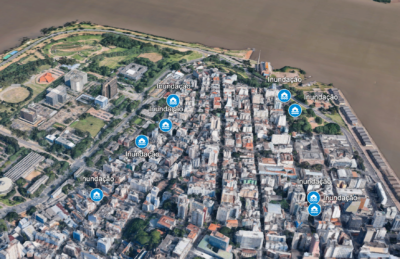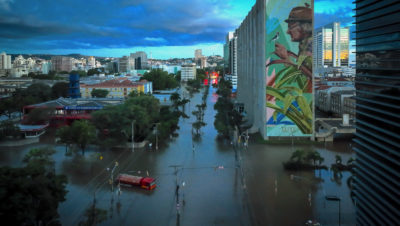When Lucas George Wendt arrived at Lajeado in late May, the waters had already begun to subside.
Only the tips of roofs and tree tops were visible above the murky brown water that had covered his hometown just a few days earlier. Lajeado, a city of 85,000 people in the Tacquarí Valley, was one of the communities hardest hit by historic floods that hit Brazil’s southernmost state, Rio Grande do Sul, from late April to mid-May, forcing more than 650,000 people to evacuate, killing 173 and injuring 806.
When Wendt arrived at the scene, 38 people were still missing. Backhoes were shoveling mud from blocked roads, city crews were clearing sidewalks with pressure washers, and volunteers were sorting donated clothing, food, personal hygiene products and bottled water.
Now living in the state capital Porto Alegre and working towards a master’s in computer sciences at the Univates de Tacuari Valley while working in communications, Wendt had returned home to check on family and friends, but also wanted to help out in some way while he was there.
The team at Citizen Map hopes that authorities will use this data to rethink urban planning and disaster recovery.
Last September, he had heard about a Unibates mapping project led by environmental engineer researcher Sofia Royer Moraes, who was studying extreme flood events in the Tacuari-Antas River basin. At the time, the Tacuari River, which runs through Lajeado, overflowed, causing the region’s worst flooding in 82 years, forcing at least 359,000 people to evacuate and killing 48. Residents of the Tacuari Valley were used to annual floods, but this one was different. Research shows that climate change is making the floods worse, and future floods are expected to cause even more deaths.
That’s when Moraes decided she could do something to help. Citizen Mapused Google Maps as a platform to allow ordinary people with their smartphones to pinpoint exactly where floodwaters would reach. These so-called citizen scientists were instructed to take photos of what they saw and send them, along with their location, to a WhatsApp group monitored by Moraes and her team. Combining that information with historical flood data for the area, the team can model what will happen during future floods and help determine the safest places for residents who have already lost everything to rebuild their lives. The models can also provide authorities with the information they need to improve urban planning and resource allocation.
Intrigued by the potential of the project, Wendt wanted to get involved: At the time, Univates was partnering with the Federal University of Rio Grande do Sul, and the goal was to map the entire state of Rio Grande do Sul.
Lukas Wendt photographed Lajeado after the floods in May. From left to right: a muddy white cross, a house still standing amongst the rubble, and a marking on a wall showing the flood height.
Lucas George Wendt
Driving around his hometown, Wendt photographed anything that might help with a civic map: a muddy white cross where a church once stood, a house standing alone among the remains of hundreds of homes washed away, water-level markings on a wall in the city center.
The 20-plus data points that Wendt collected in late May are now among the 600-plus on the constantly updated Civic Map. While Wendt knew his contribution would help others, he was surprised to see how it helped him, too.
“This has helped us understand all of these connections,” he said. “When it rains in one place, what are the impacts downstream? People who participate in these citizen science efforts are more aware, more reassured and more empowered to deal with these situations. Unfortunately, we expect to see more of these situations in the near future.”
In the context of climate change, the team behind Civic Maps hopes that Brazilian authorities will use this data to rethink everything from urban planning and post-disaster reconstruction to whether healthcare and clean drinking water will be available after a climate change-induced catastrophe. They also hope that by informing people about what’s happening around them, they will not only be more interested and willing to participate in local flood solutions, but also better prepare for what’s to come.
Climate scientists have found that burning fossil fuels has doubled the likelihood of recent heavy rains in Rio Grande do Sul state.
Experts say the severity of recent floods in southern Brazil is due to human-induced climate change. analysis A study conducted by researchers from the Pierre-Simon Laplace Institute of Climate and Environmental Sciences found that extreme weather events that occurred in Rio Grande do Sul between 2001 and 2023 brought up to 15 percent more precipitation than those that occurred between 1979 and 2001.
a Recent Research In addition, “in densely populated areas, [in] Coastal areas in southern and southeastern Brazil, as well as in the northeast, are most exposed to landslides and flooding, and these effects are predicted to worsen as the climate warms, with precipitation also increasing by 6 to 9 percent.
The first recorded floods that inundated the Tacuari Valley and other parts of Rio Grande do Sul occurred in 1941. These floods, which occurred again in April and May, left the region’s mostly rural residents without food, water and shelter. The only record of the flood’s height was a mark on the wall of a school.
“That memory sits there alone,” Wendt says of the sign, “whereas if it had happened with modern technology it could have contributed so much.”

A screenshot from the Civic Map, where blue icons show the extent of recent flooding in Porto Alegre.
University of Tacari Valley / Federal University of Rio Grande do Sul
Moraes’ first citizen map, created last September, collected data just around the affected area to determine which parts of the Takuari Valley were considered at high risk of future flooding: about 600 data points were submitted by 150 citizen scientists.
Some districts that contributed heavily to mapping the September floods are not involved in creating the new maps, likely because their areas are still difficult to access or not accessible at all. As the state continues to recover from the emergency — initially focusing on rescuing people and animals from rushing waters and collapsing buildings, and now on evacuating people to shelters or other more permanent housing — data collection is expected to slow.
“In the next few weeks, data will start coming in faster,” Moraes said. “The actual modeling of the Citizen Map will take place in July and August, when it will also be available for consultation.”
As well as using surrounding data to show the horizontal spread of water, the new maps also use data on flood heights, which are often measured by water and mud stains left on the walls of people’s homes and local businesses.
For people living downstream, information about what was happening upstream was crucial in deciding when to evacuate.
Citizen Map is currently very simple and powered by Google, but the team plans to partner with open mapping nonprofits. The Humanitarian OpenStreetMap Team To improve the visuals of the final product, Wendt said, “Google Maps has good visuals, but they’re pretty standard. We want to make the maps as easy to understand as possible to ensure they’re usable by anyone who wants to refer to them to stay safe and make the best decisions for the future.”
On May 2, when the second of three heavy rains and floods that have hit Rio Grande do Sul this year (the other two were on April 29 and May 13) began, Moraes and her team were forced to evacuate the university building where they were working. Water levels began to rise again, this time flooding inside the building.
They ended up setting up shop at a local radio station, A Hora, where they were given a workspace to work in, talked about their project on air, and were provided with a WhatsApp number for anyone who wanted to send them data or ask questions.
Soon, messages started pouring in. On May 2, about 200 people sent their locations to the Citizen Map team, who analyzed the data throughout the afternoon and evening to determine who was in or near the danger zone and who should evacuate. For people living downstream, information about what was happening upstream was crucial to making those decisions.

Flooding in Porto Alegre, May 14, 2024.
Jefferson Bernardes/Getty Images
“It’s really important for people to understand their surroundings and know if they’re in a danger zone,” Moraes said. “And people want to understand. They want to be involved.”
Anyone with a smartphone can collect data for the updated Citizen Map, but so far most of the participants have been professors and their students from universities in the area, and the hope is that more people will join as the situation on the ground starts to improve.
“I wholeheartedly support citizen science initiatives because this is exactly what is needed to help people learn and be empowered,” says Marta Ángela Marcondes, water resources expert and coordinator of the Water Pollution Index project at São Caetano do Sul Municipal University. “I believe in a process of prevention rather than remediation, and civil society is a key element in making this happen.”
Researchers hope that the Civic Map will continue to expand, eventually mapping shortages of drinking water and access to health care.
A culture of prevention is also important to Moraes: she hopes that the Civic Map will not only help Rio Grande do Sul’s residents stay safe and informed, but also guide authorities to do the same. By using the map to identify risk areas, decision-makers can improve urban planning, create better mitigation plans for future floods (such as improving storm water drainage and management systems), and build new homes, schools, health facilities, and more in safer areas.
Moraes hopes the Citizen Map will continue to expand, eventually mapping drinking water shortages, access to basic healthcare, and even cases of disease in the aftermath of climate-related crises.
“With that information, we can get a full picture by city, region and state,” she says. “As decision-makers, we can use this information to determine which areas are more vulnerable and direct the public policies we need to those areas that need it most.”
Moraes hopes that two to five years after the initial event, it will be possible to see where these public policies ultimately landed and measure their success. “In this new context of climate change, people need to be prepared,” she says. “We can’t stop these events from happening, but we can be prepared to deal with them in the best way possible.”










